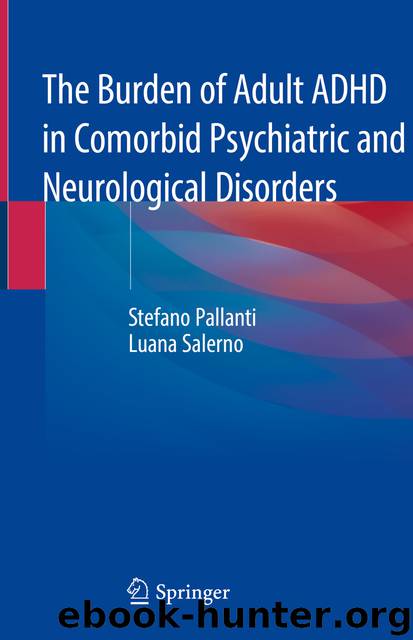The Burden of Adult ADHD in Comorbid Psychiatric and Neurological Disorders by Stefano Pallanti & Luana Salerno

Author:Stefano Pallanti & Luana Salerno
Language: eng
Format: epub
ISBN: 9783030390518
Publisher: Springer International Publishing
12.2 Clinical Point of View: Overlapping, Mimicking, and Different Symptoms
As ADHD, also OCD often presents a chronic course, with a persistence rate of 40–50% [77]. Data from neuropsychological and neuroimaging studies suggest the presence of some similar impairments to executive functions in both disorders. From a structural point of view, the anterior cingulate cortex (ACC)—an important structure for attentional and emotional processes—has been shown to be affected in both ADHD and OCD, but in an opposite way. In fact, the ACC overactivation characterizing OCD patients has been indicated as the neural correlate of the sense of “not quite right” experienced by the OCD individual [77, 78]. Instead, the ACC hypoactivation determines a reduced performance monitoring, explaining the ADHD disinhibited behavior [77]. Impaired cognitive control and performance monitoring processes characterizing both ADHD and OCD are related to dysfunctional cortico–striatal–thalamic circuits. Considering the OCD hyperactivation and the ADHD hypoactivation of some brain structures such as basal ganglia or the mesial frontal cortex, ADHD and OCD appear to be situated at the opposite ends of the impulsive–compulsive spectrum [77]. Defective inhibitory control can therefore be the cause of the perseverative and compulsive symptoms characterizing people with OCD, and be responsible for the disinhibited behavior characterizing people with ADHD [77]. However, cognitive style differentiates people with OCD from those with ADHD. Indeed, OCD cognitive style is typically marked by doubts about the individual’s performance [79], whereas children with ADHD—and to a lesser extent also adults with ADHD—are characterized by the so-called “positive illusory bias.” It consists of the overestimation of the own performance or competence [80, 81].
Both OCD and ADHD are characterized by impaired decision-making processes. People with OCD persist in their strategy of response despite the changes in the reward contingencies [82], because of an impaired learning from feedback [83] or the risk of smaller gains [84]. Instead, ADHD people show an altered sensitivity to reward [85, 86] and their performance is dominated by a “delay aversion.” As a result, they prefer immediate rather than delayed rewards (and therefore small gains immediately, rather than greater gain but postponed) [87]. It has been reported that people with both ADHD and OCD have neuropsychological deficits that are more attenuated than “pure” ADHD [18]. OCD–ADHD comorbidity has been suggested as a distinct subgroup of OCD, characterized by an underlying dysfunction of motor and cognitive inhibition, determining the onset of hyperactivity, obsessions, and compulsions [22]. ADHD and early-onset OCD can be linked by genetic factors. In fact, a study found that children at risk of OCD had first-degree relatives with both OCD and ADHD, leading authors to hypothesize that these conditions could be inherited together [25]. Moreover, twin and family studies in OCD and ADHD suggested high familiarity in both disorders [88, 89] and, in presence of relatives affected by ADHD, the patients with ADHD were more at risk of OCD than those without relatives with ADHD [90].
Even though ADHD and OCD are very different in their phenomenology, both conditions are characterized by inattentive symptoms. It is not simple to differentiate inattention symptoms of ADHD from inattention due to OCD [26].
Download
This site does not store any files on its server. We only index and link to content provided by other sites. Please contact the content providers to delete copyright contents if any and email us, we'll remove relevant links or contents immediately.
When Breath Becomes Air by Paul Kalanithi(7264)
Why We Sleep: Unlocking the Power of Sleep and Dreams by Matthew Walker(5642)
Paper Towns by Green John(4169)
The Immortal Life of Henrietta Lacks by Rebecca Skloot(3826)
The Sports Rules Book by Human Kinetics(3588)
Dynamic Alignment Through Imagery by Eric Franklin(3489)
ACSM's Complete Guide to Fitness & Health by ACSM(3468)
Kaplan MCAT Organic Chemistry Review: Created for MCAT 2015 (Kaplan Test Prep) by Kaplan(3423)
Introduction to Kinesiology by Shirl J. Hoffman(3301)
Livewired by David Eagleman(3122)
The River of Consciousness by Oliver Sacks(2992)
Alchemy and Alchemists by C. J. S. Thompson(2911)
The Death of the Heart by Elizabeth Bowen(2901)
Descartes' Error by Antonio Damasio(2731)
Bad Pharma by Ben Goldacre(2730)
Kaplan MCAT Behavioral Sciences Review: Created for MCAT 2015 (Kaplan Test Prep) by Kaplan(2492)
The Gene: An Intimate History by Siddhartha Mukherjee(2491)
The Fate of Rome: Climate, Disease, and the End of an Empire (The Princeton History of the Ancient World) by Kyle Harper(2436)
The Emperor of All Maladies: A Biography of Cancer by Siddhartha Mukherjee(2431)
